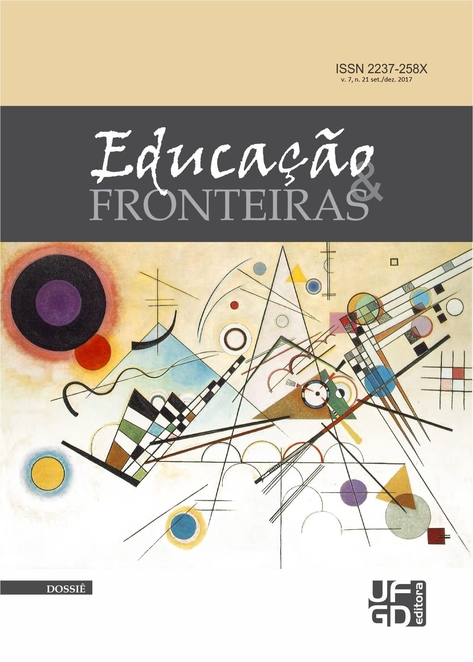The freireana’s approach and Jigsaw methodology: a report on the potentialities and limitations for Chemistry teaching
DOI:
https://doi.org/10.30612/eduf.v7i21.8060Keywords:
Teaching. Cooperative learning. Paulo Freire.Abstract
The present research report is the result of a didactic sequence anchored at the Paulo Freire´s perspective under humanistic education as a form of world intervention, and in the cooperative learning in which the Jigsaw´s methodology is inserted. It was developed with first-year high school students from a state public school in the city of Dourados-MS. The theme developed was "lightning, lightning and thunder", in which we worked on some chemical concepts directly related to the theme and the curricular reference. The research is of qualitative and quantitative nature, and had as methodology of data analysis the Discursive Textual Analysis (DTA). From the analysis came two final categories, in which they gave rise to two metatexts called: 1) Electrical phenomena as interfering agents in nature and in human life; 2) Chemical concepts: electric field, conductive materials and insulation. Given the studies and analyzes carried out, the reconciliation of the humanistic perspective with the cooperative learning contributed to the formation of critical-reflexive citizens, and made it possible to investigate potentialities and limitations of the references used during the activityDownloads
References
COELHO, J. C.; MARQUES, C. A. Contribuições freireanas para a contextualização no ensino de Química. Ensaio Pesquisa em Educação em Ciências, Belo Horizonte, v. 9, n. 1, p. 49-61, 2009.
FIORENTINI, Dario. Pesquisar práticas colaborativas ou pesquisar colaborativamente? In: BORBA, M. C., LOILA, J. Pesquisa Qualitativa em Educação Matemática. Belo Horizonte: Autêntica, 2ª Ed. 2006. FREIRE, P. Pedagogia da Autonomia: saberes necessários à prática educativa. Rio de Janeiro, Paz e Terra. 2014 a.
FREIRE, P. Pedagogia do oprimido. Rio de janeiro. Paz e Terra, 2014b.
GONÇALVES, C. Utilização do formol em alisamento capilar para ensinar conceitos de ligações intermoleculares sob a perspectiva freireana. TCC (Graduação em química) – Universidade Federal da Grande Dourados, Dourados. 2015.
HEERDT, B.; BRANDT, C. F. Aprendizagem cooperativa/colaborativa com o uso da webquest em aulas de biologia. ANPEDSUL. VII Seminário de pesquisa em educação da Região Sul. Pesquisa em educação e inserção social. UNIVALE. Itajaí. Santa Catarina. 2008.
JOHNSON, D.W.; JOHNSON, R.T.; HOLUBEC, E.J. Los nuevos círculos delaprendizaje: lacooperaciónenel aula y laescuela. Virginia: Aique, 1999.
MORAES, R; GALIAZZI, M.C. Análise Textual Discursiva. ed.Unijuí, 2007.
MOREIRA, H.; CALEFFE, L.G. Metodologia da pesquisa para o professor pesquisador. 2. Ed., Rio de janeiro: Lamparina, 2008.
MÜHL, E. H. Problematização. In: STRECK, D. R.; REDIN, E.; ZITKOSKI, J. J. (Org.) Dicionário Paulo Freire. Belo Horizonte, Autêntica, 2010.
OLIVEIRA, A. M.; RECINA, M. C. P. O ensino de polímeros na perspectiva da educação dialógica com enfoque em CTS. Alexandria Revista de Educação em Ciência e Tecnologia, v.7, n.1, p.103-126, mai. 2014.
SILVA, E. S. A física dos relâmpagos e dos raios. TCC (Graduação em física) – Universidade Católica de Brasília, Brasília. 2007.
SILVA, V. A. A aprendizagem colaborativa como método de apropriação do conhecimento químico em sala de aula. Dissertação (Mestrado em Educação Em Ciências E Matemática) - Universidade Federal De Goiás, Goiânia. 2011.
TEODORO, D. L.; CABRAL, P. F. O.; QUEIROZ, S. L., Atividade cooperativa no formato Jigsaw: Um estudo no ensino superior de química. Alexandria Revista de Educação em Ciência e Tecnologia, v. 8, n. 1, p. 21-51, 2015.









